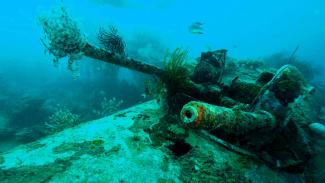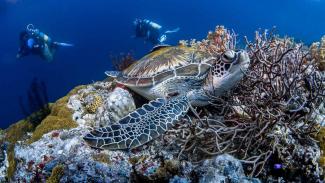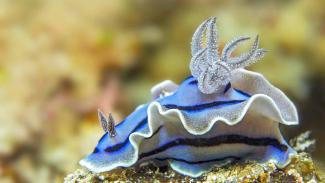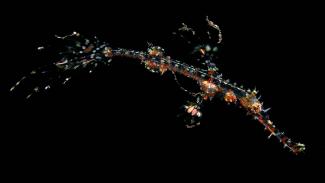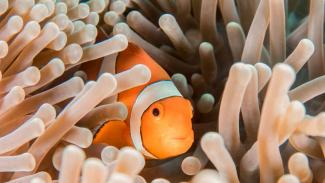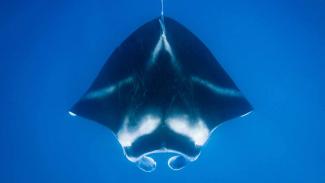Find out everything you need to know about scuba diving in Borneo

Tara North
For most people, Borneo conjures up visions of pristine rainforests and incredible wildlife encounters. This is all true, however for scuba divers, the magic continues beneath the blue.
Scuba diving in Borneo promises world-class dive sites, vibrant reefs and incredible marine life, from the green turtles of Sipadan Island to remote and spectacular diving in Borneo Indonesia.
Here, we answer your essential questions to help you plan the perfect diving vacation to Borneo. Read on to discover everything you need to know about Borneo’s diving season, best diving spots, and much more.
Where is Borneo?
Borneo is in South-east Asia. It lies east of Peninsular Malaysia, south-west of the Philippines and north of much of Indonesia. It is a huge island, the third largest in the world and home to a diverse array of experiences, from impressive mountains and beautiful beaches to ancient rainforest and iconic wildlife encounters.
Borneo may be the third largest island in the world, and one of the most celebrated, but it is not a country. In fact, Borneo comprises three countries, Malaysia, Indonesia and Brunei.
Much of the northern part of the island is given over to the Malaysian states of Sarawak and Sabah. Sabah in the north-east is where you’ll find a number of Borneo’s best diving spots, including Sipadan Island and Layang Layang. The gateway to Sabah is the regional capital of Kota Kinabalu, however those wishing to dive Sipadan and Mabul need to head to Tawau.
Also on the northern coast is Brunei, while the remainder of the island, known as Kalimantan, is part of Indonesia. Borneo Indonesia has exceptional diving around Derawan and Maratua, a group of islands on the eastern coast of the island. These are a little more difficult to reach than some of the dive sites in Malaysian Borneo (see our section below on getting to Borneo's best scuba diving sites) but those that make the journey will be rewarded with truly exceptional diving.

Fahrul Azmi

When is Borneo’s best diving season?
Borneo lies firmly within the tropics, straddling the equator and sees warm temperatures, rainfall and high humidity throughout the year.
The majority of the best dive sites are on the eastern coastline and follow a similar pattern for both weather and diving seasons.
From Kota Kinabalu in northern Sabah, round the coast to Sipadan and down the Indonesian dive sites of Maratua, Derawan and Sangalaki, the best diving season coincides with the dry season. This period runs from March each year through to October. It can still rain during this period, but conditions are generally more conducive to scuba diving, with sunnier days and calmer seas.
Don’t think this is the only time you can scuba dive these diving locations however. Outside these months, the north-east monsoon means more rainfall and less reliable conditions, but underwater the diving remains world-class. Between November and February, the south side of Sipadan offers the opportunity to encounter Hammerhead Sharks, giving another draw to diving ‘out of season’.
The diving areas on Borneo’s northern coast, both in Brunei and Miri in the Malaysian state of Sarawak have similar seasons, albeit with a slightly shorter dry season. The best time to dive these diving sites is from March through to September, with May and June often bringing the best visibility. During the monsoon season, visibility can also drop.
Layang Layang, out in the South China Sea north of Borneo, can only be dived from March through to August each year, with April and May bringing the chance of Hammerhead Sharks. Outside of these months, the islands are closed to tourists and divers.


Tara North
Can I stay on Sipadan Island?
This is a common question for those looking to scuba dive in Borneo. The answer, in a word, is 'no'! There are no dive resorts on Sipadan Island itself. There are plenty of accommodation choices on Mabul, Kapalai or Mataking Island.
Diving at Sipadan is controlled with a strict permit system, so make sure your chosen dive resort has permits for diving Sipadan and know that you wish to apply for a permit!


Fahrul Azmi
How much does it cost to dive in Borneo?
Borneo may not be the cheapest place in the world to scuba dive, but it does not have to be very expensive. Many of the dive resorts in the most famous diving areas offer packages that include accommodation, meals, and up to three dives per day. Often transfers can be included too. So the upfront price can appear on the high side, but most of your costs are taken care of in advance.
We recommend to book your Borneo diving vacation with the friendly team at Dive the World. In addition to two decades of experience arranging adventures for scuba divers, great reasons to book with Dive the World include a best price guarantee, free dive insurance for first time customers and generous loyalty rewards for repeat guests.
Some of the more luxurious options around Sipadan are Sipadan Water Village, the magical Kapalai Dive Resort and the exceptional Mabul Water Bungalows - possibly the most luxurious option in the area. For those looking to spend a little less, Borneo Divers Mabul or Sipadan Mabul Resort are good options to consider.
Away from Sipadan, Lankayan Island Dive Resort is another exceptional option at the higher end of the price range, while Layang Layang Dive Resort costs a little more due to the charter flights required to get to and from the resort. While there are luxurious resorts around Kota Kinabalu, there are also options to dive on a budget.
On the Indonesian side of Borneo, the dive resorts can be a little more difficult to reach, which needs to be factored into your vacation planning. However for those looking to dive each day, resort packages at most resorts are very well priced considering the remote location.
The diving in Brunei is also gaining a reputation for its scuba diving, particularly wreck diving and is a great option for those on a tighter budget.



